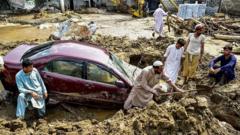More than 200 people remain untraceable in Buner district, one of the worst-hit areas of north-west Pakistan, due to catastrophic flooding and landslides from a brutal monsoon season, an official confirmed. Flash floods have led to over 300 fatalities throughout Pakistan and Pakistan-administered Kashmir in recent days, particularly affecting the mountainous region of Khyber Pakhtunkhwa.
A local official disclosed to the BBC that 209 individuals are still reported missing in Buner, despite fears the number may increase. Eight unidentified bodies were laid to rest by rescue teams, as no surviving relatives could be located, according to Jehangir Khan, spokesperson for Buner's deputy commissioner office. Further complicating recovery efforts, relatives struggle to retrieve bodies due to severely damaged transportation routes.
Provincial rescue services informed AFP that "10 to 12 complete villages" have suffered partial burial. Asfandyar Khattak, head of the provincial disaster management authority, indicated that dozens of people were also reported missing in nearby Shangla district.
South Asia typically receives about 75% of its annual rainfall during monsoon months from June to September. Though flash floods and landslides are a frequent occurrence, the intensity and frequency of these disasters have escalated due to climate change, as highlighted by scientists.
Indian-administered Kashmir has also faced similar torrential rain recently, following flash floods that resulted in at least 60 casualties. In Pakistan-administered Kashmir, the recent downpour claimed nine lives, while five fatalities were reported in the Gilgit-Baltistan region.
Government meteorologists predict that heavy rainfall will persist until at least August 21 in the northwestern region, with several areas designated as disaster zones. Pakistan continues to grapple with the aftermath of this year's monsoon season, which has already resulted in a loss of at least 650 lives.
In July, Punjab, which accommodates nearly half of Pakistan's 255 million population, experienced 73% more rainfall than the previous year, contributing to a higher death toll than seen during the last monsoon season. Northern Pakistan, known for its glaciated landscapes, is undergoing rapid glacier retreat due to climate change, raising concerns about the stability of mountain soil and debris.
While the specific causes of the recent floods and landslides remain under investigation, glaciologists assert that melting ice is likely a significant factor contributing to the devastation.
A local official disclosed to the BBC that 209 individuals are still reported missing in Buner, despite fears the number may increase. Eight unidentified bodies were laid to rest by rescue teams, as no surviving relatives could be located, according to Jehangir Khan, spokesperson for Buner's deputy commissioner office. Further complicating recovery efforts, relatives struggle to retrieve bodies due to severely damaged transportation routes.
Provincial rescue services informed AFP that "10 to 12 complete villages" have suffered partial burial. Asfandyar Khattak, head of the provincial disaster management authority, indicated that dozens of people were also reported missing in nearby Shangla district.
South Asia typically receives about 75% of its annual rainfall during monsoon months from June to September. Though flash floods and landslides are a frequent occurrence, the intensity and frequency of these disasters have escalated due to climate change, as highlighted by scientists.
Indian-administered Kashmir has also faced similar torrential rain recently, following flash floods that resulted in at least 60 casualties. In Pakistan-administered Kashmir, the recent downpour claimed nine lives, while five fatalities were reported in the Gilgit-Baltistan region.
Government meteorologists predict that heavy rainfall will persist until at least August 21 in the northwestern region, with several areas designated as disaster zones. Pakistan continues to grapple with the aftermath of this year's monsoon season, which has already resulted in a loss of at least 650 lives.
In July, Punjab, which accommodates nearly half of Pakistan's 255 million population, experienced 73% more rainfall than the previous year, contributing to a higher death toll than seen during the last monsoon season. Northern Pakistan, known for its glaciated landscapes, is undergoing rapid glacier retreat due to climate change, raising concerns about the stability of mountain soil and debris.
While the specific causes of the recent floods and landslides remain under investigation, glaciologists assert that melting ice is likely a significant factor contributing to the devastation.



















